Unit 35: Developing Individuals, Teams, and Organisations - HR Report
VerifiedAdded on 2021/04/17
|15
|4213
|32
Report
AI Summary
This report analyzes the skills and attributes required of HR professionals, including communication, ethics, conflict management, and organizational skills. It includes a personal SWOT analysis and a personal development plan tailored for an HR Manager role, outlining short-term, mid-term, and long-term goals. The report also introduces Accenture, examining continuous professional development (CPD) and its importance for individual and organizational growth. It evaluates high-performance work (HPW) practices and their contribution to employee engagement and motivation, providing examples and recommendations for improvement. The report emphasizes the value of CPD for maintaining skills, remaining competitive, and aligning with organizational standards, while also discussing the benefits of HPW in fostering a motivated and skilled workforce.
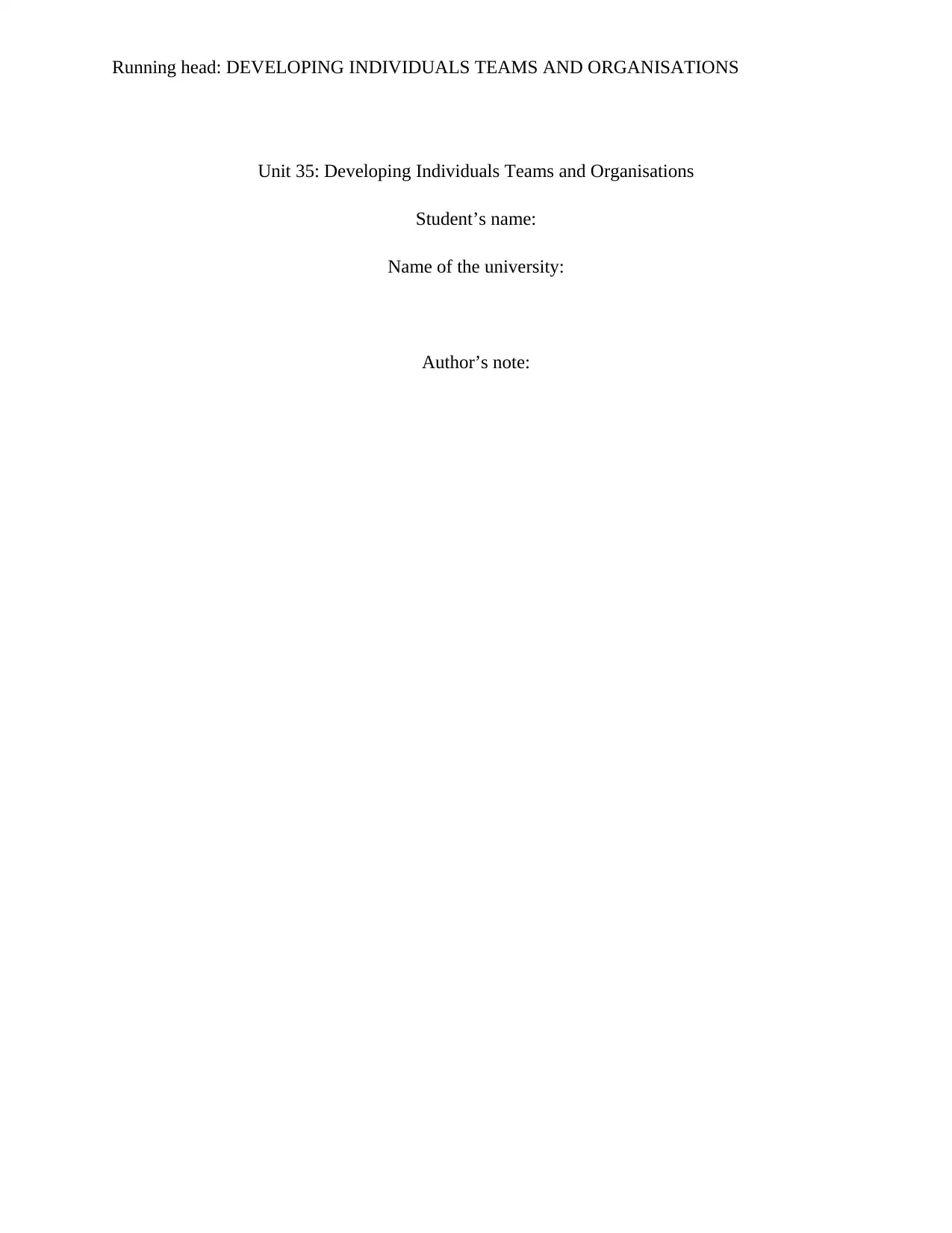
Running head: DEVELOPING INDIVIDUALS TEAMS AND ORGANISATIONS
Unit 35: Developing Individuals Teams and Organisations
Student’s name:
Name of the university:
Author’s note:
Unit 35: Developing Individuals Teams and Organisations
Student’s name:
Name of the university:
Author’s note:
Paraphrase This Document
Need a fresh take? Get an instant paraphrase of this document with our AI Paraphraser
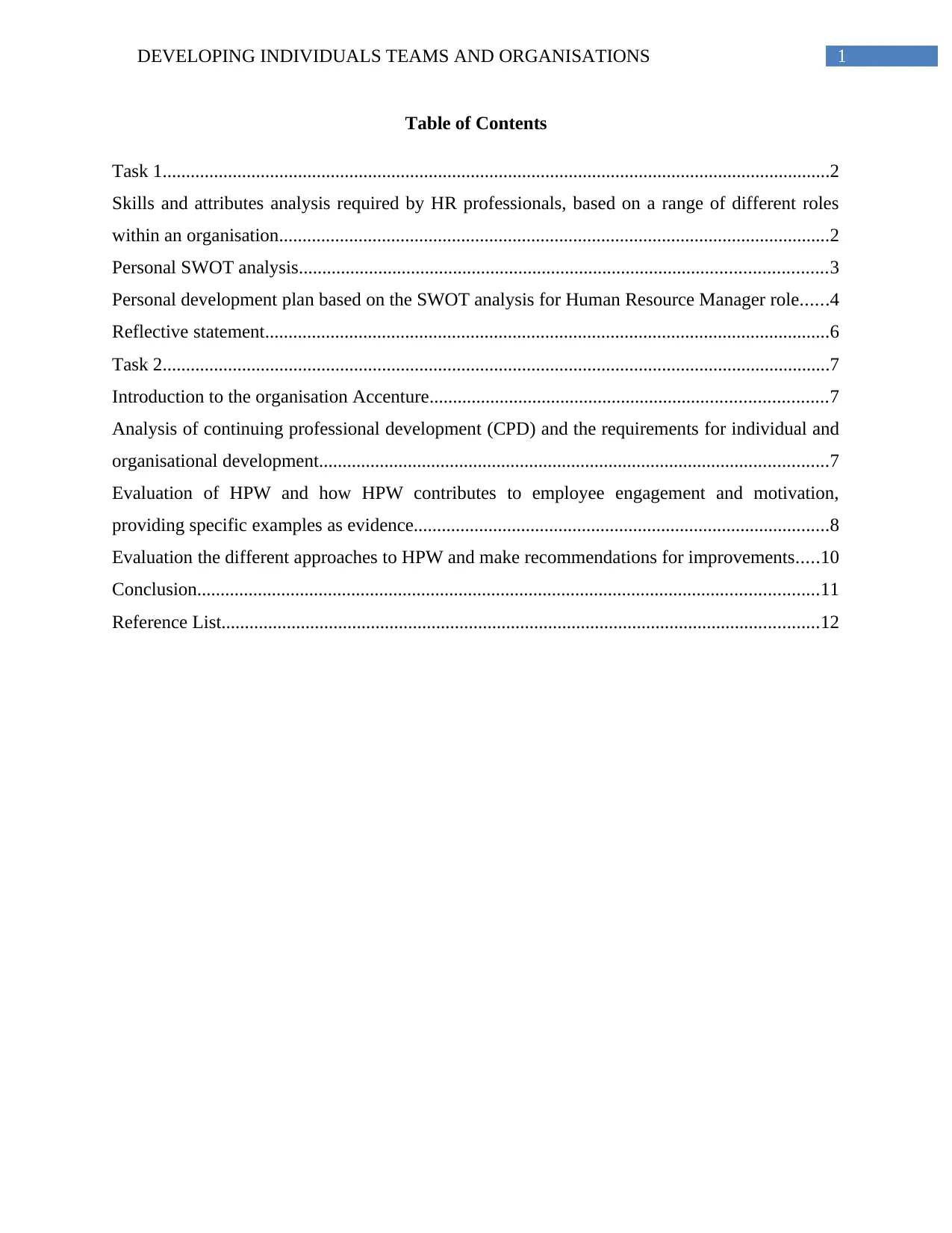
1DEVELOPING INDIVIDUALS TEAMS AND ORGANISATIONS
Table of Contents
Task 1...............................................................................................................................................2
Skills and attributes analysis required by HR professionals, based on a range of different roles
within an organisation......................................................................................................................2
Personal SWOT analysis.................................................................................................................3
Personal development plan based on the SWOT analysis for Human Resource Manager role......4
Reflective statement.........................................................................................................................6
Task 2...............................................................................................................................................7
Introduction to the organisation Accenture.....................................................................................7
Analysis of continuing professional development (CPD) and the requirements for individual and
organisational development.............................................................................................................7
Evaluation of HPW and how HPW contributes to employee engagement and motivation,
providing specific examples as evidence.........................................................................................8
Evaluation the different approaches to HPW and make recommendations for improvements.....10
Conclusion.....................................................................................................................................11
Reference List................................................................................................................................12
Table of Contents
Task 1...............................................................................................................................................2
Skills and attributes analysis required by HR professionals, based on a range of different roles
within an organisation......................................................................................................................2
Personal SWOT analysis.................................................................................................................3
Personal development plan based on the SWOT analysis for Human Resource Manager role......4
Reflective statement.........................................................................................................................6
Task 2...............................................................................................................................................7
Introduction to the organisation Accenture.....................................................................................7
Analysis of continuing professional development (CPD) and the requirements for individual and
organisational development.............................................................................................................7
Evaluation of HPW and how HPW contributes to employee engagement and motivation,
providing specific examples as evidence.........................................................................................8
Evaluation the different approaches to HPW and make recommendations for improvements.....10
Conclusion.....................................................................................................................................11
Reference List................................................................................................................................12
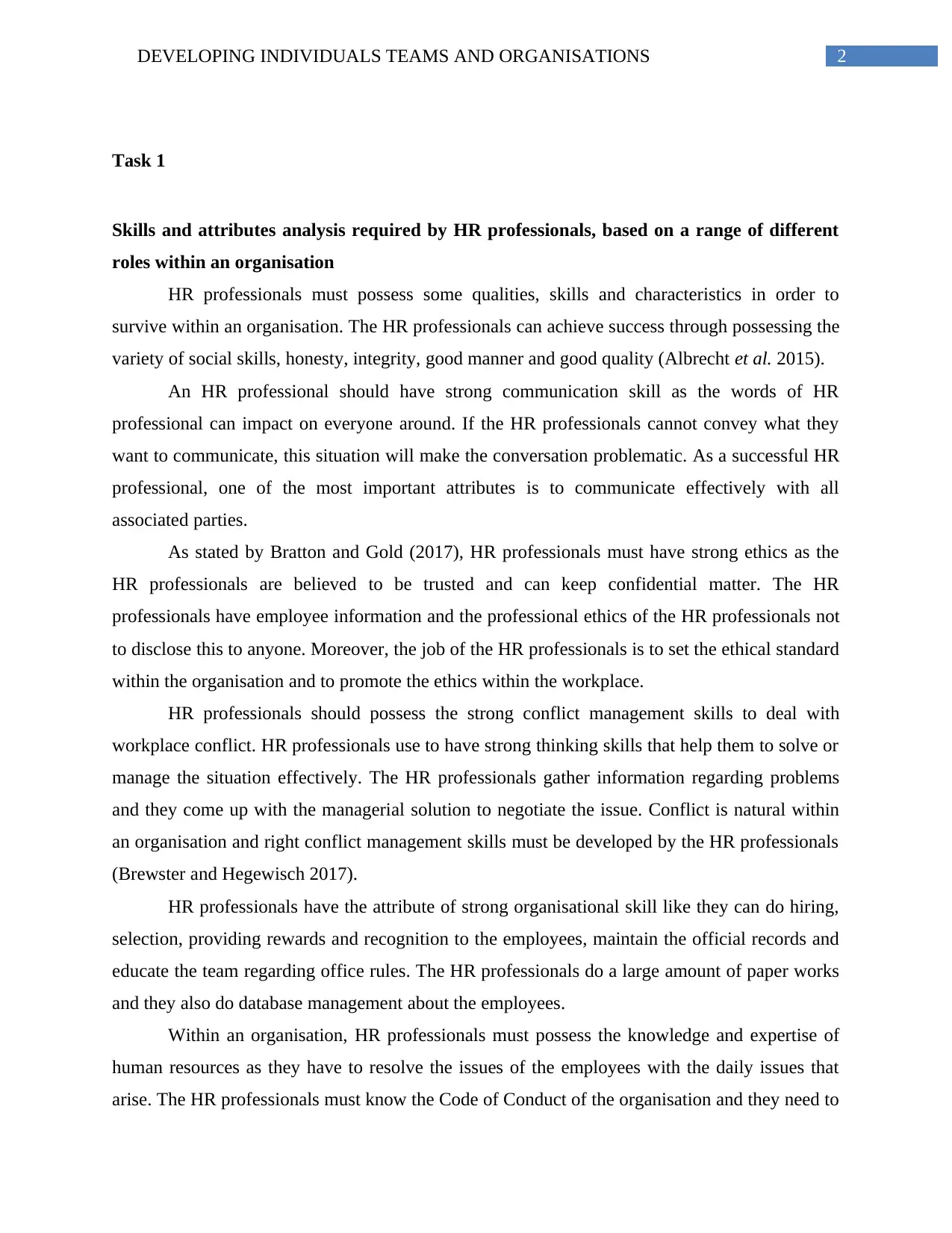
2DEVELOPING INDIVIDUALS TEAMS AND ORGANISATIONS
Task 1
Skills and attributes analysis required by HR professionals, based on a range of different
roles within an organisation
HR professionals must possess some qualities, skills and characteristics in order to
survive within an organisation. The HR professionals can achieve success through possessing the
variety of social skills, honesty, integrity, good manner and good quality (Albrecht et al. 2015).
An HR professional should have strong communication skill as the words of HR
professional can impact on everyone around. If the HR professionals cannot convey what they
want to communicate, this situation will make the conversation problematic. As a successful HR
professional, one of the most important attributes is to communicate effectively with all
associated parties.
As stated by Bratton and Gold (2017), HR professionals must have strong ethics as the
HR professionals are believed to be trusted and can keep confidential matter. The HR
professionals have employee information and the professional ethics of the HR professionals not
to disclose this to anyone. Moreover, the job of the HR professionals is to set the ethical standard
within the organisation and to promote the ethics within the workplace.
HR professionals should possess the strong conflict management skills to deal with
workplace conflict. HR professionals use to have strong thinking skills that help them to solve or
manage the situation effectively. The HR professionals gather information regarding problems
and they come up with the managerial solution to negotiate the issue. Conflict is natural within
an organisation and right conflict management skills must be developed by the HR professionals
(Brewster and Hegewisch 2017).
HR professionals have the attribute of strong organisational skill like they can do hiring,
selection, providing rewards and recognition to the employees, maintain the official records and
educate the team regarding office rules. The HR professionals do a large amount of paper works
and they also do database management about the employees.
Within an organisation, HR professionals must possess the knowledge and expertise of
human resources as they have to resolve the issues of the employees with the daily issues that
arise. The HR professionals must know the Code of Conduct of the organisation and they need to
Task 1
Skills and attributes analysis required by HR professionals, based on a range of different
roles within an organisation
HR professionals must possess some qualities, skills and characteristics in order to
survive within an organisation. The HR professionals can achieve success through possessing the
variety of social skills, honesty, integrity, good manner and good quality (Albrecht et al. 2015).
An HR professional should have strong communication skill as the words of HR
professional can impact on everyone around. If the HR professionals cannot convey what they
want to communicate, this situation will make the conversation problematic. As a successful HR
professional, one of the most important attributes is to communicate effectively with all
associated parties.
As stated by Bratton and Gold (2017), HR professionals must have strong ethics as the
HR professionals are believed to be trusted and can keep confidential matter. The HR
professionals have employee information and the professional ethics of the HR professionals not
to disclose this to anyone. Moreover, the job of the HR professionals is to set the ethical standard
within the organisation and to promote the ethics within the workplace.
HR professionals should possess the strong conflict management skills to deal with
workplace conflict. HR professionals use to have strong thinking skills that help them to solve or
manage the situation effectively. The HR professionals gather information regarding problems
and they come up with the managerial solution to negotiate the issue. Conflict is natural within
an organisation and right conflict management skills must be developed by the HR professionals
(Brewster and Hegewisch 2017).
HR professionals have the attribute of strong organisational skill like they can do hiring,
selection, providing rewards and recognition to the employees, maintain the official records and
educate the team regarding office rules. The HR professionals do a large amount of paper works
and they also do database management about the employees.
Within an organisation, HR professionals must possess the knowledge and expertise of
human resources as they have to resolve the issues of the employees with the daily issues that
arise. The HR professionals must know the Code of Conduct of the organisation and they need to
⊘ This is a preview!⊘
Do you want full access?
Subscribe today to unlock all pages.

Trusted by 1+ million students worldwide
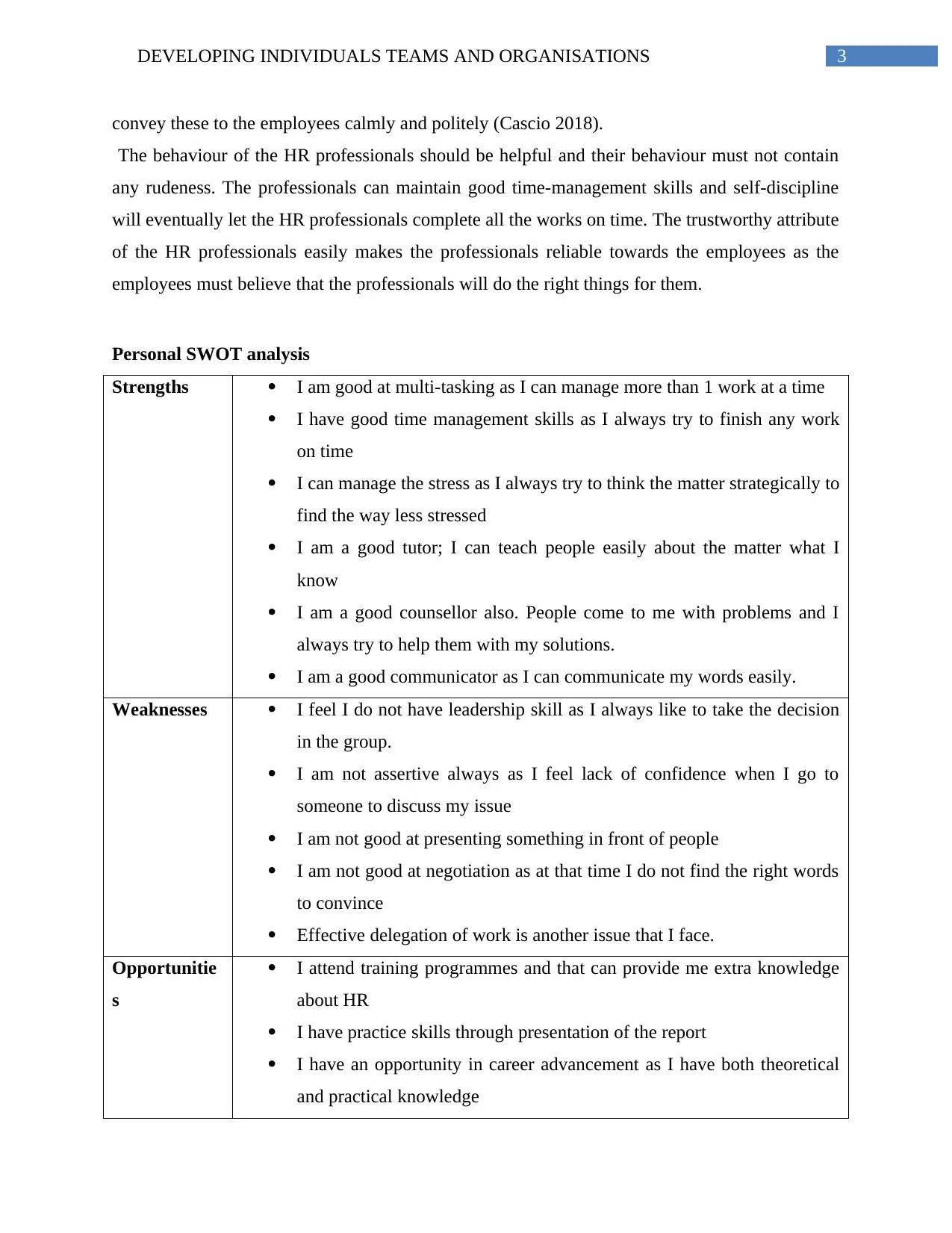
3DEVELOPING INDIVIDUALS TEAMS AND ORGANISATIONS
convey these to the employees calmly and politely (Cascio 2018).
The behaviour of the HR professionals should be helpful and their behaviour must not contain
any rudeness. The professionals can maintain good time-management skills and self-discipline
will eventually let the HR professionals complete all the works on time. The trustworthy attribute
of the HR professionals easily makes the professionals reliable towards the employees as the
employees must believe that the professionals will do the right things for them.
Personal SWOT analysis
Strengths I am good at multi-tasking as I can manage more than 1 work at a time
I have good time management skills as I always try to finish any work
on time
I can manage the stress as I always try to think the matter strategically to
find the way less stressed
I am a good tutor; I can teach people easily about the matter what I
know
I am a good counsellor also. People come to me with problems and I
always try to help them with my solutions.
I am a good communicator as I can communicate my words easily.
Weaknesses I feel I do not have leadership skill as I always like to take the decision
in the group.
I am not assertive always as I feel lack of confidence when I go to
someone to discuss my issue
I am not good at presenting something in front of people
I am not good at negotiation as at that time I do not find the right words
to convince
Effective delegation of work is another issue that I face.
Opportunitie
s
I attend training programmes and that can provide me extra knowledge
about HR
I have practice skills through presentation of the report
I have an opportunity in career advancement as I have both theoretical
and practical knowledge
convey these to the employees calmly and politely (Cascio 2018).
The behaviour of the HR professionals should be helpful and their behaviour must not contain
any rudeness. The professionals can maintain good time-management skills and self-discipline
will eventually let the HR professionals complete all the works on time. The trustworthy attribute
of the HR professionals easily makes the professionals reliable towards the employees as the
employees must believe that the professionals will do the right things for them.
Personal SWOT analysis
Strengths I am good at multi-tasking as I can manage more than 1 work at a time
I have good time management skills as I always try to finish any work
on time
I can manage the stress as I always try to think the matter strategically to
find the way less stressed
I am a good tutor; I can teach people easily about the matter what I
know
I am a good counsellor also. People come to me with problems and I
always try to help them with my solutions.
I am a good communicator as I can communicate my words easily.
Weaknesses I feel I do not have leadership skill as I always like to take the decision
in the group.
I am not assertive always as I feel lack of confidence when I go to
someone to discuss my issue
I am not good at presenting something in front of people
I am not good at negotiation as at that time I do not find the right words
to convince
Effective delegation of work is another issue that I face.
Opportunitie
s
I attend training programmes and that can provide me extra knowledge
about HR
I have practice skills through presentation of the report
I have an opportunity in career advancement as I have both theoretical
and practical knowledge
Paraphrase This Document
Need a fresh take? Get an instant paraphrase of this document with our AI Paraphraser
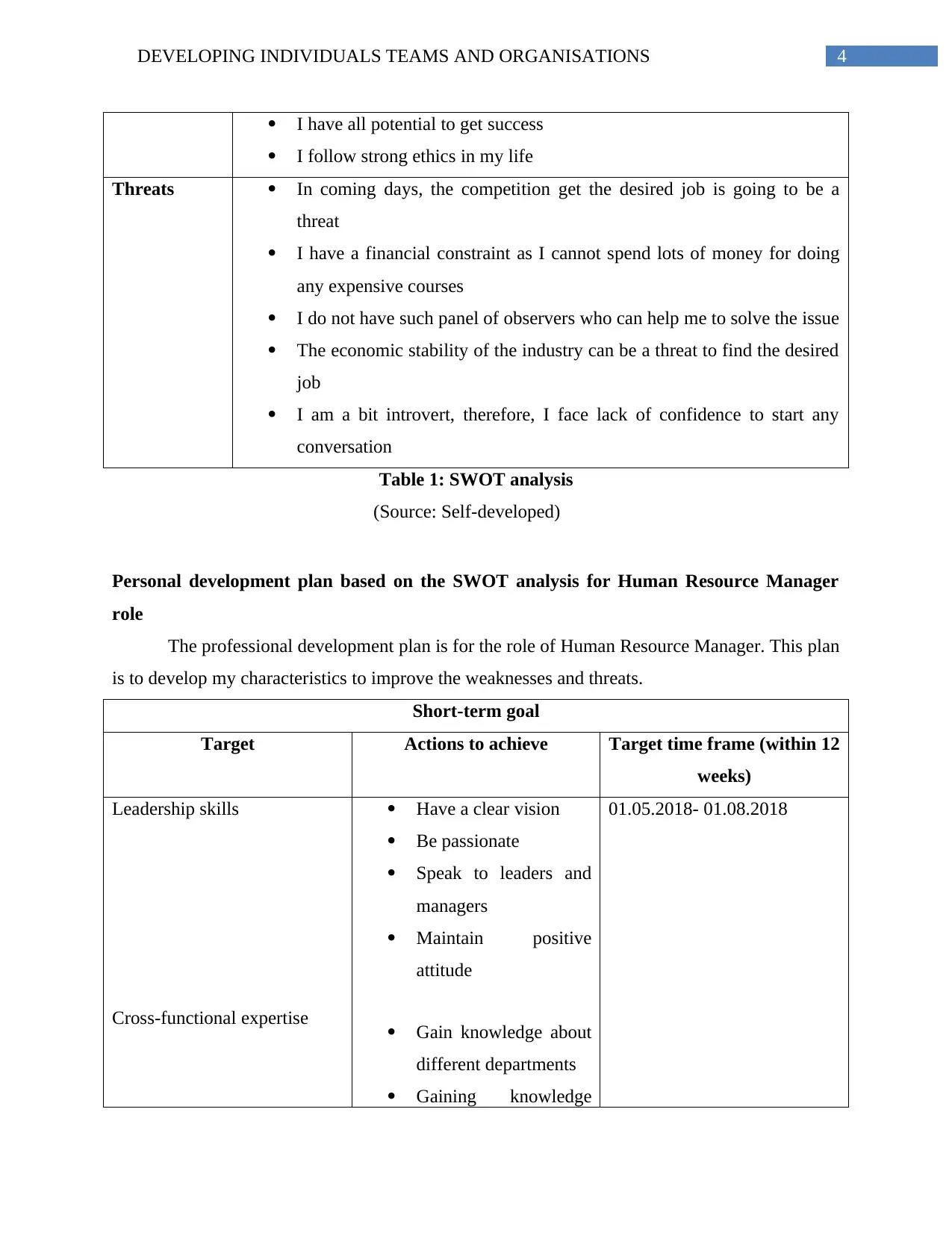
4DEVELOPING INDIVIDUALS TEAMS AND ORGANISATIONS
I have all potential to get success
I follow strong ethics in my life
Threats In coming days, the competition get the desired job is going to be a
threat
I have a financial constraint as I cannot spend lots of money for doing
any expensive courses
I do not have such panel of observers who can help me to solve the issue
The economic stability of the industry can be a threat to find the desired
job
I am a bit introvert, therefore, I face lack of confidence to start any
conversation
Table 1: SWOT analysis
(Source: Self-developed)
Personal development plan based on the SWOT analysis for Human Resource Manager
role
The professional development plan is for the role of Human Resource Manager. This plan
is to develop my characteristics to improve the weaknesses and threats.
Short-term goal
Target Actions to achieve Target time frame (within 12
weeks)
Leadership skills
Cross-functional expertise
Have a clear vision
Be passionate
Speak to leaders and
managers
Maintain positive
attitude
Gain knowledge about
different departments
Gaining knowledge
01.05.2018- 01.08.2018
I have all potential to get success
I follow strong ethics in my life
Threats In coming days, the competition get the desired job is going to be a
threat
I have a financial constraint as I cannot spend lots of money for doing
any expensive courses
I do not have such panel of observers who can help me to solve the issue
The economic stability of the industry can be a threat to find the desired
job
I am a bit introvert, therefore, I face lack of confidence to start any
conversation
Table 1: SWOT analysis
(Source: Self-developed)
Personal development plan based on the SWOT analysis for Human Resource Manager
role
The professional development plan is for the role of Human Resource Manager. This plan
is to develop my characteristics to improve the weaknesses and threats.
Short-term goal
Target Actions to achieve Target time frame (within 12
weeks)
Leadership skills
Cross-functional expertise
Have a clear vision
Be passionate
Speak to leaders and
managers
Maintain positive
attitude
Gain knowledge about
different departments
Gaining knowledge
01.05.2018- 01.08.2018
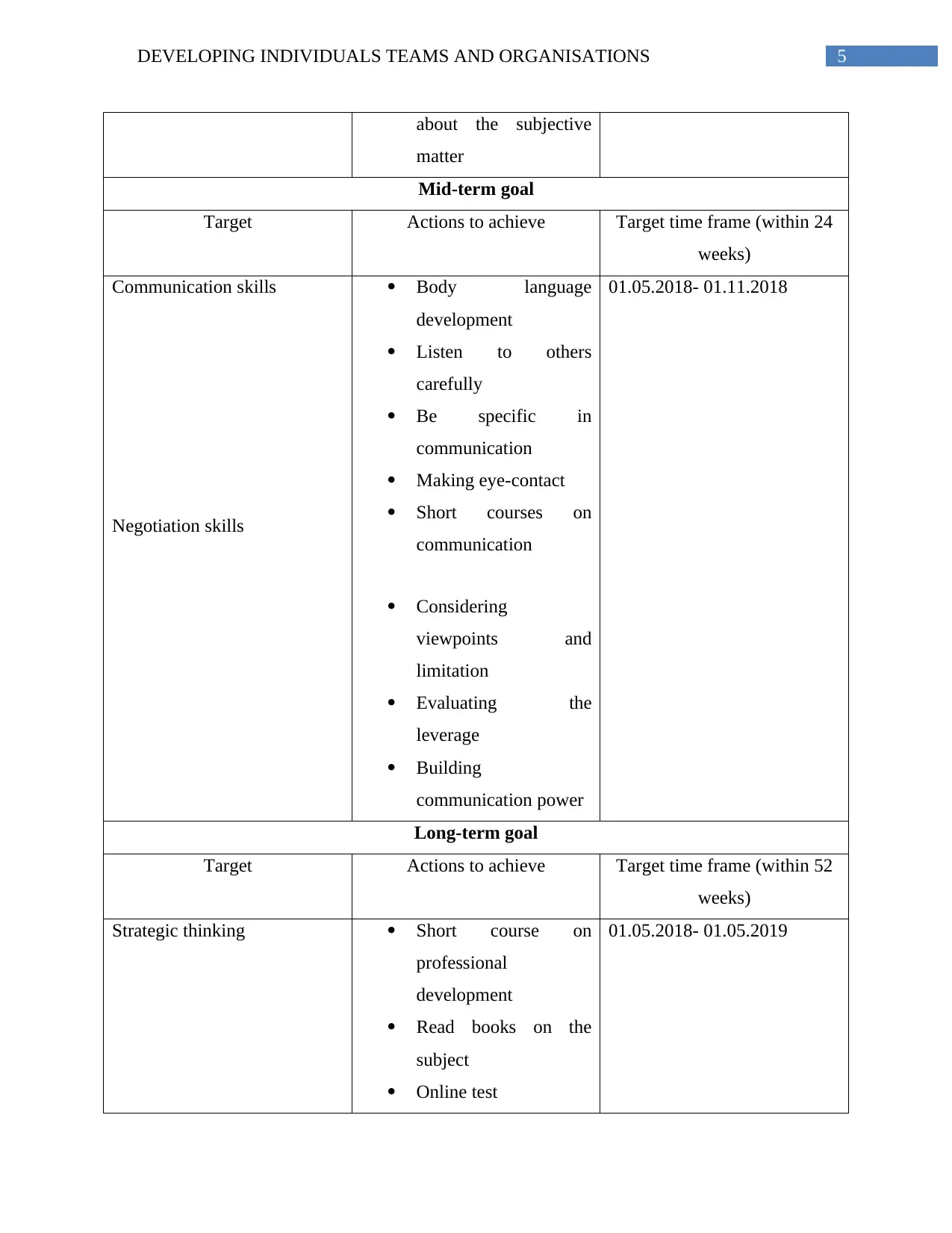
5DEVELOPING INDIVIDUALS TEAMS AND ORGANISATIONS
about the subjective
matter
Mid-term goal
Target Actions to achieve Target time frame (within 24
weeks)
Communication skills
Negotiation skills
Body language
development
Listen to others
carefully
Be specific in
communication
Making eye-contact
Short courses on
communication
Considering
viewpoints and
limitation
Evaluating the
leverage
Building
communication power
01.05.2018- 01.11.2018
Long-term goal
Target Actions to achieve Target time frame (within 52
weeks)
Strategic thinking Short course on
professional
development
Read books on the
subject
Online test
01.05.2018- 01.05.2019
about the subjective
matter
Mid-term goal
Target Actions to achieve Target time frame (within 24
weeks)
Communication skills
Negotiation skills
Body language
development
Listen to others
carefully
Be specific in
communication
Making eye-contact
Short courses on
communication
Considering
viewpoints and
limitation
Evaluating the
leverage
Building
communication power
01.05.2018- 01.11.2018
Long-term goal
Target Actions to achieve Target time frame (within 52
weeks)
Strategic thinking Short course on
professional
development
Read books on the
subject
Online test
01.05.2018- 01.05.2019
⊘ This is a preview!⊘
Do you want full access?
Subscribe today to unlock all pages.

Trusted by 1+ million students worldwide
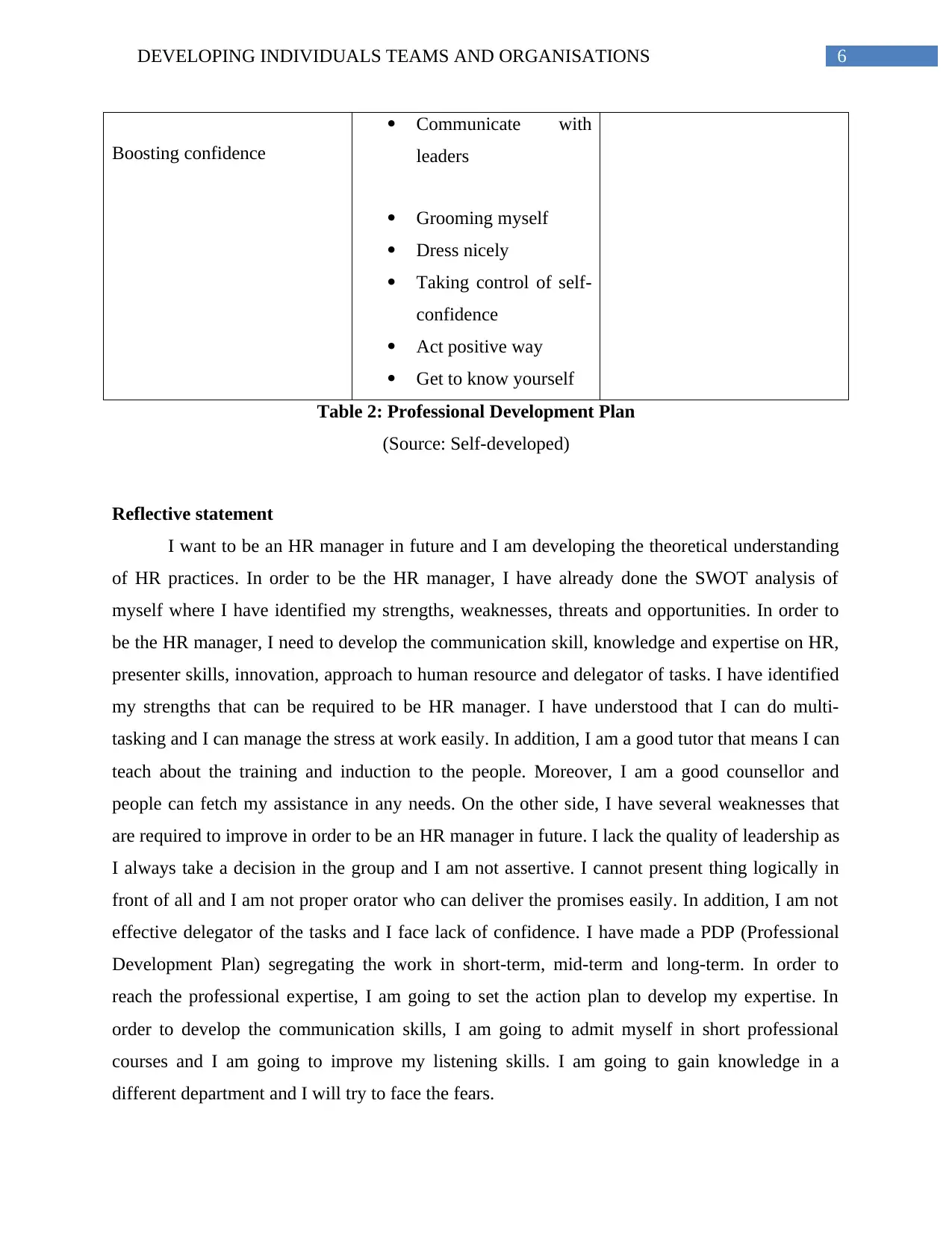
6DEVELOPING INDIVIDUALS TEAMS AND ORGANISATIONS
Boosting confidence
Communicate with
leaders
Grooming myself
Dress nicely
Taking control of self-
confidence
Act positive way
Get to know yourself
Table 2: Professional Development Plan
(Source: Self-developed)
Reflective statement
I want to be an HR manager in future and I am developing the theoretical understanding
of HR practices. In order to be the HR manager, I have already done the SWOT analysis of
myself where I have identified my strengths, weaknesses, threats and opportunities. In order to
be the HR manager, I need to develop the communication skill, knowledge and expertise on HR,
presenter skills, innovation, approach to human resource and delegator of tasks. I have identified
my strengths that can be required to be HR manager. I have understood that I can do multi-
tasking and I can manage the stress at work easily. In addition, I am a good tutor that means I can
teach about the training and induction to the people. Moreover, I am a good counsellor and
people can fetch my assistance in any needs. On the other side, I have several weaknesses that
are required to improve in order to be an HR manager in future. I lack the quality of leadership as
I always take a decision in the group and I am not assertive. I cannot present thing logically in
front of all and I am not proper orator who can deliver the promises easily. In addition, I am not
effective delegator of the tasks and I face lack of confidence. I have made a PDP (Professional
Development Plan) segregating the work in short-term, mid-term and long-term. In order to
reach the professional expertise, I am going to set the action plan to develop my expertise. In
order to develop the communication skills, I am going to admit myself in short professional
courses and I am going to improve my listening skills. I am going to gain knowledge in a
different department and I will try to face the fears.
Boosting confidence
Communicate with
leaders
Grooming myself
Dress nicely
Taking control of self-
confidence
Act positive way
Get to know yourself
Table 2: Professional Development Plan
(Source: Self-developed)
Reflective statement
I want to be an HR manager in future and I am developing the theoretical understanding
of HR practices. In order to be the HR manager, I have already done the SWOT analysis of
myself where I have identified my strengths, weaknesses, threats and opportunities. In order to
be the HR manager, I need to develop the communication skill, knowledge and expertise on HR,
presenter skills, innovation, approach to human resource and delegator of tasks. I have identified
my strengths that can be required to be HR manager. I have understood that I can do multi-
tasking and I can manage the stress at work easily. In addition, I am a good tutor that means I can
teach about the training and induction to the people. Moreover, I am a good counsellor and
people can fetch my assistance in any needs. On the other side, I have several weaknesses that
are required to improve in order to be an HR manager in future. I lack the quality of leadership as
I always take a decision in the group and I am not assertive. I cannot present thing logically in
front of all and I am not proper orator who can deliver the promises easily. In addition, I am not
effective delegator of the tasks and I face lack of confidence. I have made a PDP (Professional
Development Plan) segregating the work in short-term, mid-term and long-term. In order to
reach the professional expertise, I am going to set the action plan to develop my expertise. In
order to develop the communication skills, I am going to admit myself in short professional
courses and I am going to improve my listening skills. I am going to gain knowledge in a
different department and I will try to face the fears.
Paraphrase This Document
Need a fresh take? Get an instant paraphrase of this document with our AI Paraphraser
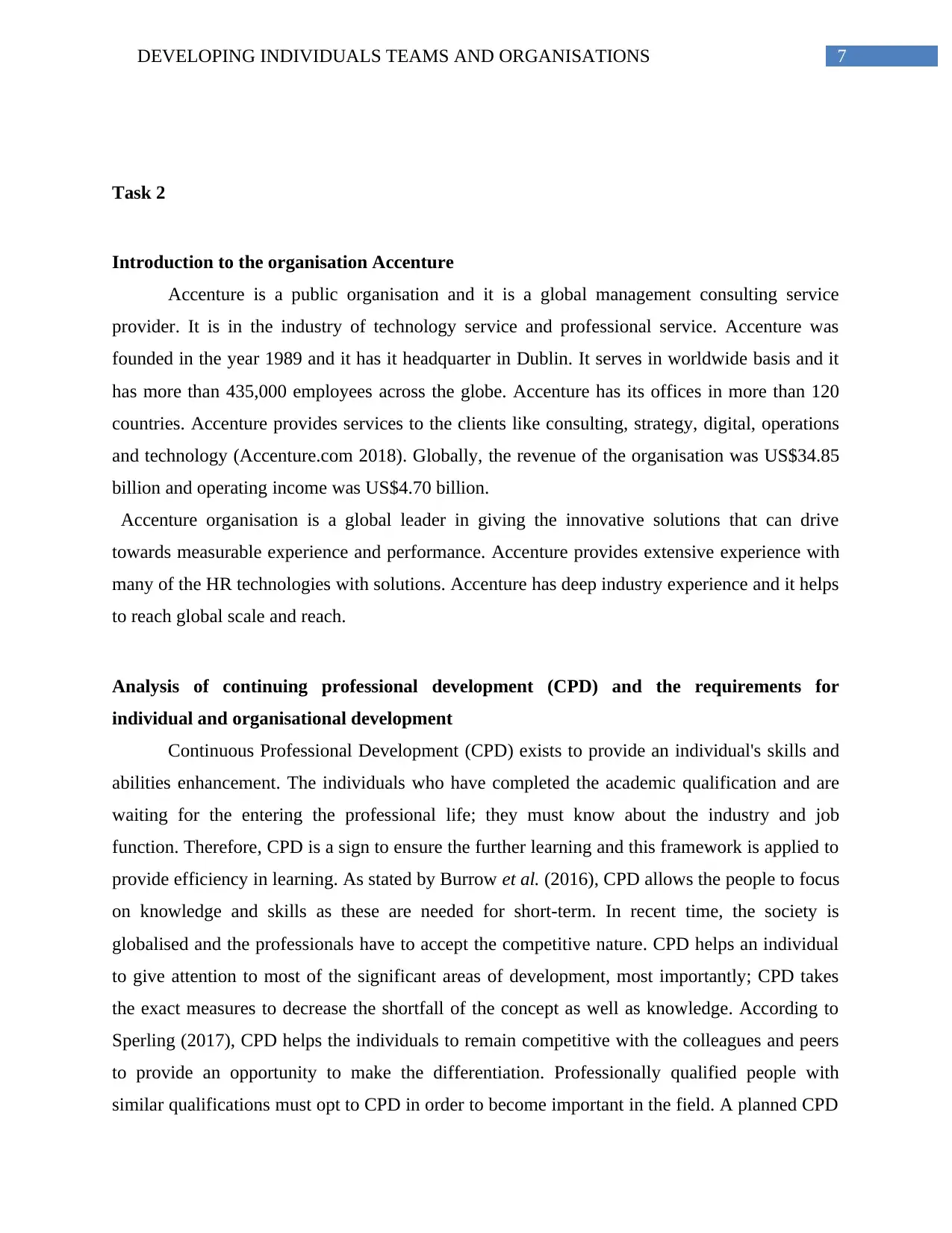
7DEVELOPING INDIVIDUALS TEAMS AND ORGANISATIONS
Task 2
Introduction to the organisation Accenture
Accenture is a public organisation and it is a global management consulting service
provider. It is in the industry of technology service and professional service. Accenture was
founded in the year 1989 and it has it headquarter in Dublin. It serves in worldwide basis and it
has more than 435,000 employees across the globe. Accenture has its offices in more than 120
countries. Accenture provides services to the clients like consulting, strategy, digital, operations
and technology (Accenture.com 2018). Globally, the revenue of the organisation was US$34.85
billion and operating income was US$4.70 billion.
Accenture organisation is a global leader in giving the innovative solutions that can drive
towards measurable experience and performance. Accenture provides extensive experience with
many of the HR technologies with solutions. Accenture has deep industry experience and it helps
to reach global scale and reach.
Analysis of continuing professional development (CPD) and the requirements for
individual and organisational development
Continuous Professional Development (CPD) exists to provide an individual's skills and
abilities enhancement. The individuals who have completed the academic qualification and are
waiting for the entering the professional life; they must know about the industry and job
function. Therefore, CPD is a sign to ensure the further learning and this framework is applied to
provide efficiency in learning. As stated by Burrow et al. (2016), CPD allows the people to focus
on knowledge and skills as these are needed for short-term. In recent time, the society is
globalised and the professionals have to accept the competitive nature. CPD helps an individual
to give attention to most of the significant areas of development, most importantly; CPD takes
the exact measures to decrease the shortfall of the concept as well as knowledge. According to
Sperling (2017), CPD helps the individuals to remain competitive with the colleagues and peers
to provide an opportunity to make the differentiation. Professionally qualified people with
similar qualifications must opt to CPD in order to become important in the field. A planned CPD
Task 2
Introduction to the organisation Accenture
Accenture is a public organisation and it is a global management consulting service
provider. It is in the industry of technology service and professional service. Accenture was
founded in the year 1989 and it has it headquarter in Dublin. It serves in worldwide basis and it
has more than 435,000 employees across the globe. Accenture has its offices in more than 120
countries. Accenture provides services to the clients like consulting, strategy, digital, operations
and technology (Accenture.com 2018). Globally, the revenue of the organisation was US$34.85
billion and operating income was US$4.70 billion.
Accenture organisation is a global leader in giving the innovative solutions that can drive
towards measurable experience and performance. Accenture provides extensive experience with
many of the HR technologies with solutions. Accenture has deep industry experience and it helps
to reach global scale and reach.
Analysis of continuing professional development (CPD) and the requirements for
individual and organisational development
Continuous Professional Development (CPD) exists to provide an individual's skills and
abilities enhancement. The individuals who have completed the academic qualification and are
waiting for the entering the professional life; they must know about the industry and job
function. Therefore, CPD is a sign to ensure the further learning and this framework is applied to
provide efficiency in learning. As stated by Burrow et al. (2016), CPD allows the people to focus
on knowledge and skills as these are needed for short-term. In recent time, the society is
globalised and the professionals have to accept the competitive nature. CPD helps an individual
to give attention to most of the significant areas of development, most importantly; CPD takes
the exact measures to decrease the shortfall of the concept as well as knowledge. According to
Sperling (2017), CPD helps the individuals to remain competitive with the colleagues and peers
to provide an opportunity to make the differentiation. Professionally qualified people with
similar qualifications must opt to CPD in order to become important in the field. A planned CPD
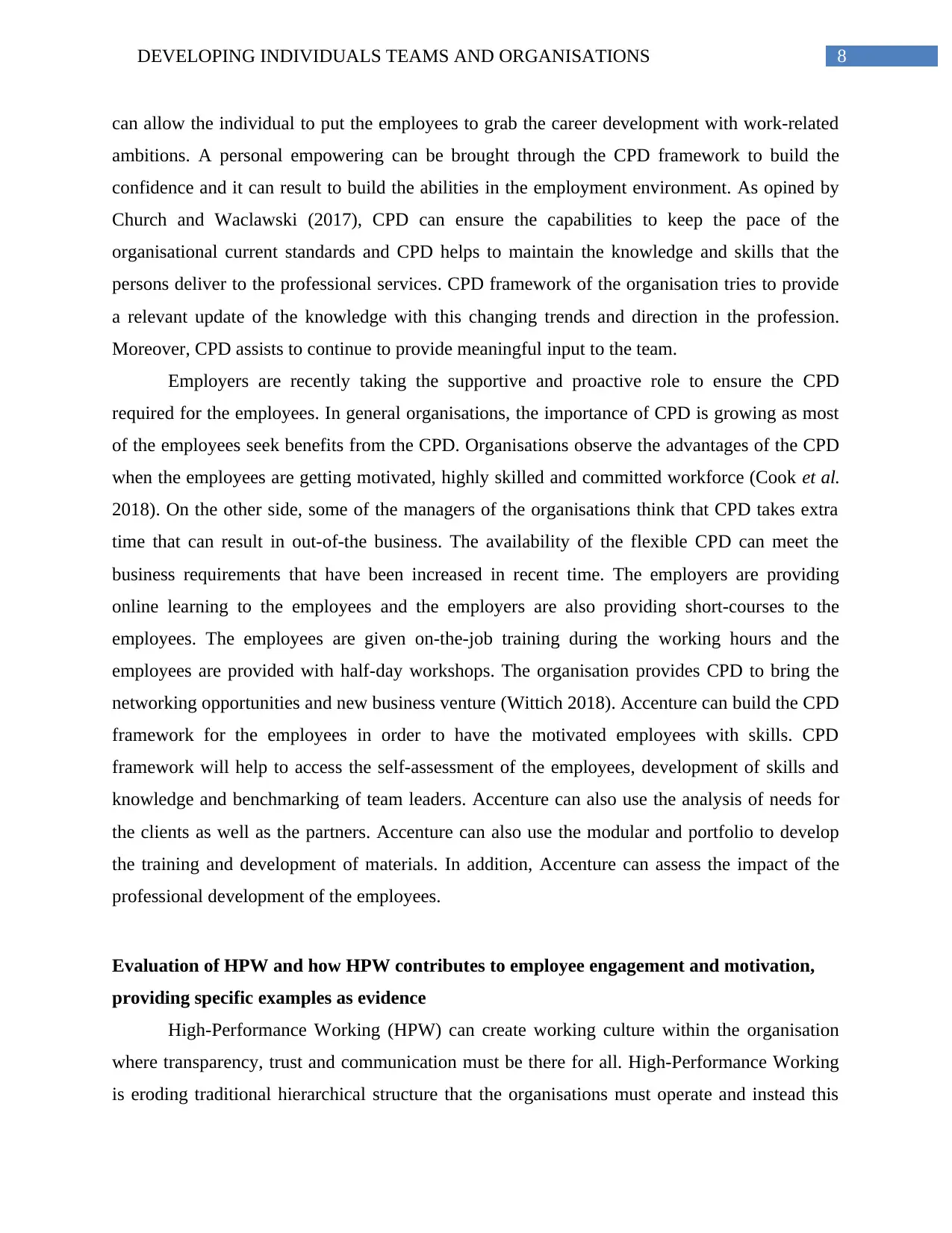
8DEVELOPING INDIVIDUALS TEAMS AND ORGANISATIONS
can allow the individual to put the employees to grab the career development with work-related
ambitions. A personal empowering can be brought through the CPD framework to build the
confidence and it can result to build the abilities in the employment environment. As opined by
Church and Waclawski (2017), CPD can ensure the capabilities to keep the pace of the
organisational current standards and CPD helps to maintain the knowledge and skills that the
persons deliver to the professional services. CPD framework of the organisation tries to provide
a relevant update of the knowledge with this changing trends and direction in the profession.
Moreover, CPD assists to continue to provide meaningful input to the team.
Employers are recently taking the supportive and proactive role to ensure the CPD
required for the employees. In general organisations, the importance of CPD is growing as most
of the employees seek benefits from the CPD. Organisations observe the advantages of the CPD
when the employees are getting motivated, highly skilled and committed workforce (Cook et al.
2018). On the other side, some of the managers of the organisations think that CPD takes extra
time that can result in out-of-the business. The availability of the flexible CPD can meet the
business requirements that have been increased in recent time. The employers are providing
online learning to the employees and the employers are also providing short-courses to the
employees. The employees are given on-the-job training during the working hours and the
employees are provided with half-day workshops. The organisation provides CPD to bring the
networking opportunities and new business venture (Wittich 2018). Accenture can build the CPD
framework for the employees in order to have the motivated employees with skills. CPD
framework will help to access the self-assessment of the employees, development of skills and
knowledge and benchmarking of team leaders. Accenture can also use the analysis of needs for
the clients as well as the partners. Accenture can also use the modular and portfolio to develop
the training and development of materials. In addition, Accenture can assess the impact of the
professional development of the employees.
Evaluation of HPW and how HPW contributes to employee engagement and motivation,
providing specific examples as evidence
High-Performance Working (HPW) can create working culture within the organisation
where transparency, trust and communication must be there for all. High-Performance Working
is eroding traditional hierarchical structure that the organisations must operate and instead this
can allow the individual to put the employees to grab the career development with work-related
ambitions. A personal empowering can be brought through the CPD framework to build the
confidence and it can result to build the abilities in the employment environment. As opined by
Church and Waclawski (2017), CPD can ensure the capabilities to keep the pace of the
organisational current standards and CPD helps to maintain the knowledge and skills that the
persons deliver to the professional services. CPD framework of the organisation tries to provide
a relevant update of the knowledge with this changing trends and direction in the profession.
Moreover, CPD assists to continue to provide meaningful input to the team.
Employers are recently taking the supportive and proactive role to ensure the CPD
required for the employees. In general organisations, the importance of CPD is growing as most
of the employees seek benefits from the CPD. Organisations observe the advantages of the CPD
when the employees are getting motivated, highly skilled and committed workforce (Cook et al.
2018). On the other side, some of the managers of the organisations think that CPD takes extra
time that can result in out-of-the business. The availability of the flexible CPD can meet the
business requirements that have been increased in recent time. The employers are providing
online learning to the employees and the employers are also providing short-courses to the
employees. The employees are given on-the-job training during the working hours and the
employees are provided with half-day workshops. The organisation provides CPD to bring the
networking opportunities and new business venture (Wittich 2018). Accenture can build the CPD
framework for the employees in order to have the motivated employees with skills. CPD
framework will help to access the self-assessment of the employees, development of skills and
knowledge and benchmarking of team leaders. Accenture can also use the analysis of needs for
the clients as well as the partners. Accenture can also use the modular and portfolio to develop
the training and development of materials. In addition, Accenture can assess the impact of the
professional development of the employees.
Evaluation of HPW and how HPW contributes to employee engagement and motivation,
providing specific examples as evidence
High-Performance Working (HPW) can create working culture within the organisation
where transparency, trust and communication must be there for all. High-Performance Working
is eroding traditional hierarchical structure that the organisations must operate and instead this
⊘ This is a preview!⊘
Do you want full access?
Subscribe today to unlock all pages.

Trusted by 1+ million students worldwide
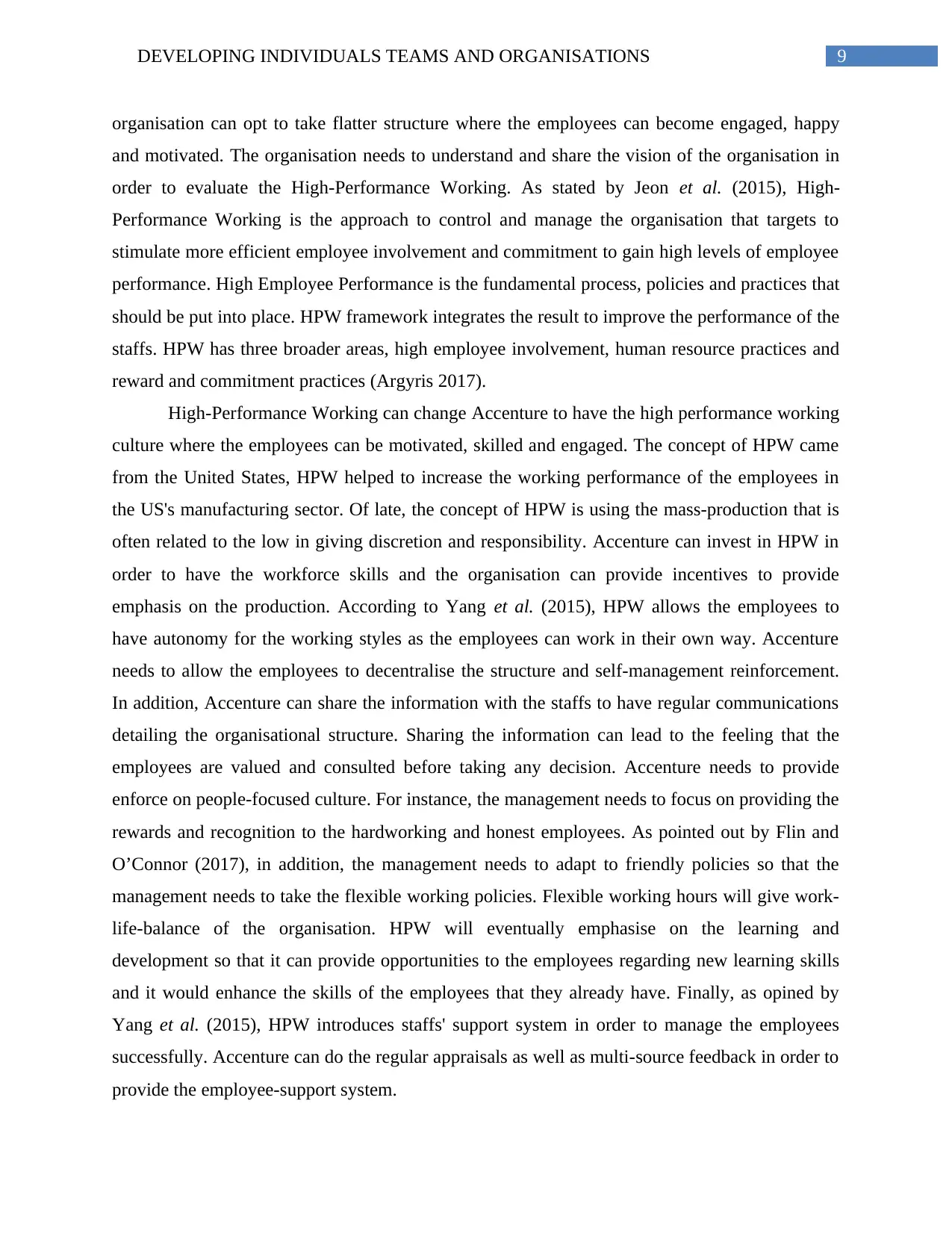
9DEVELOPING INDIVIDUALS TEAMS AND ORGANISATIONS
organisation can opt to take flatter structure where the employees can become engaged, happy
and motivated. The organisation needs to understand and share the vision of the organisation in
order to evaluate the High-Performance Working. As stated by Jeon et al. (2015), High-
Performance Working is the approach to control and manage the organisation that targets to
stimulate more efficient employee involvement and commitment to gain high levels of employee
performance. High Employee Performance is the fundamental process, policies and practices that
should be put into place. HPW framework integrates the result to improve the performance of the
staffs. HPW has three broader areas, high employee involvement, human resource practices and
reward and commitment practices (Argyris 2017).
High-Performance Working can change Accenture to have the high performance working
culture where the employees can be motivated, skilled and engaged. The concept of HPW came
from the United States, HPW helped to increase the working performance of the employees in
the US's manufacturing sector. Of late, the concept of HPW is using the mass-production that is
often related to the low in giving discretion and responsibility. Accenture can invest in HPW in
order to have the workforce skills and the organisation can provide incentives to provide
emphasis on the production. According to Yang et al. (2015), HPW allows the employees to
have autonomy for the working styles as the employees can work in their own way. Accenture
needs to allow the employees to decentralise the structure and self-management reinforcement.
In addition, Accenture can share the information with the staffs to have regular communications
detailing the organisational structure. Sharing the information can lead to the feeling that the
employees are valued and consulted before taking any decision. Accenture needs to provide
enforce on people-focused culture. For instance, the management needs to focus on providing the
rewards and recognition to the hardworking and honest employees. As pointed out by Flin and
O’Connor (2017), in addition, the management needs to adapt to friendly policies so that the
management needs to take the flexible working policies. Flexible working hours will give work-
life-balance of the organisation. HPW will eventually emphasise on the learning and
development so that it can provide opportunities to the employees regarding new learning skills
and it would enhance the skills of the employees that they already have. Finally, as opined by
Yang et al. (2015), HPW introduces staffs' support system in order to manage the employees
successfully. Accenture can do the regular appraisals as well as multi-source feedback in order to
provide the employee-support system.
organisation can opt to take flatter structure where the employees can become engaged, happy
and motivated. The organisation needs to understand and share the vision of the organisation in
order to evaluate the High-Performance Working. As stated by Jeon et al. (2015), High-
Performance Working is the approach to control and manage the organisation that targets to
stimulate more efficient employee involvement and commitment to gain high levels of employee
performance. High Employee Performance is the fundamental process, policies and practices that
should be put into place. HPW framework integrates the result to improve the performance of the
staffs. HPW has three broader areas, high employee involvement, human resource practices and
reward and commitment practices (Argyris 2017).
High-Performance Working can change Accenture to have the high performance working
culture where the employees can be motivated, skilled and engaged. The concept of HPW came
from the United States, HPW helped to increase the working performance of the employees in
the US's manufacturing sector. Of late, the concept of HPW is using the mass-production that is
often related to the low in giving discretion and responsibility. Accenture can invest in HPW in
order to have the workforce skills and the organisation can provide incentives to provide
emphasis on the production. According to Yang et al. (2015), HPW allows the employees to
have autonomy for the working styles as the employees can work in their own way. Accenture
needs to allow the employees to decentralise the structure and self-management reinforcement.
In addition, Accenture can share the information with the staffs to have regular communications
detailing the organisational structure. Sharing the information can lead to the feeling that the
employees are valued and consulted before taking any decision. Accenture needs to provide
enforce on people-focused culture. For instance, the management needs to focus on providing the
rewards and recognition to the hardworking and honest employees. As pointed out by Flin and
O’Connor (2017), in addition, the management needs to adapt to friendly policies so that the
management needs to take the flexible working policies. Flexible working hours will give work-
life-balance of the organisation. HPW will eventually emphasise on the learning and
development so that it can provide opportunities to the employees regarding new learning skills
and it would enhance the skills of the employees that they already have. Finally, as opined by
Yang et al. (2015), HPW introduces staffs' support system in order to manage the employees
successfully. Accenture can do the regular appraisals as well as multi-source feedback in order to
provide the employee-support system.
Paraphrase This Document
Need a fresh take? Get an instant paraphrase of this document with our AI Paraphraser
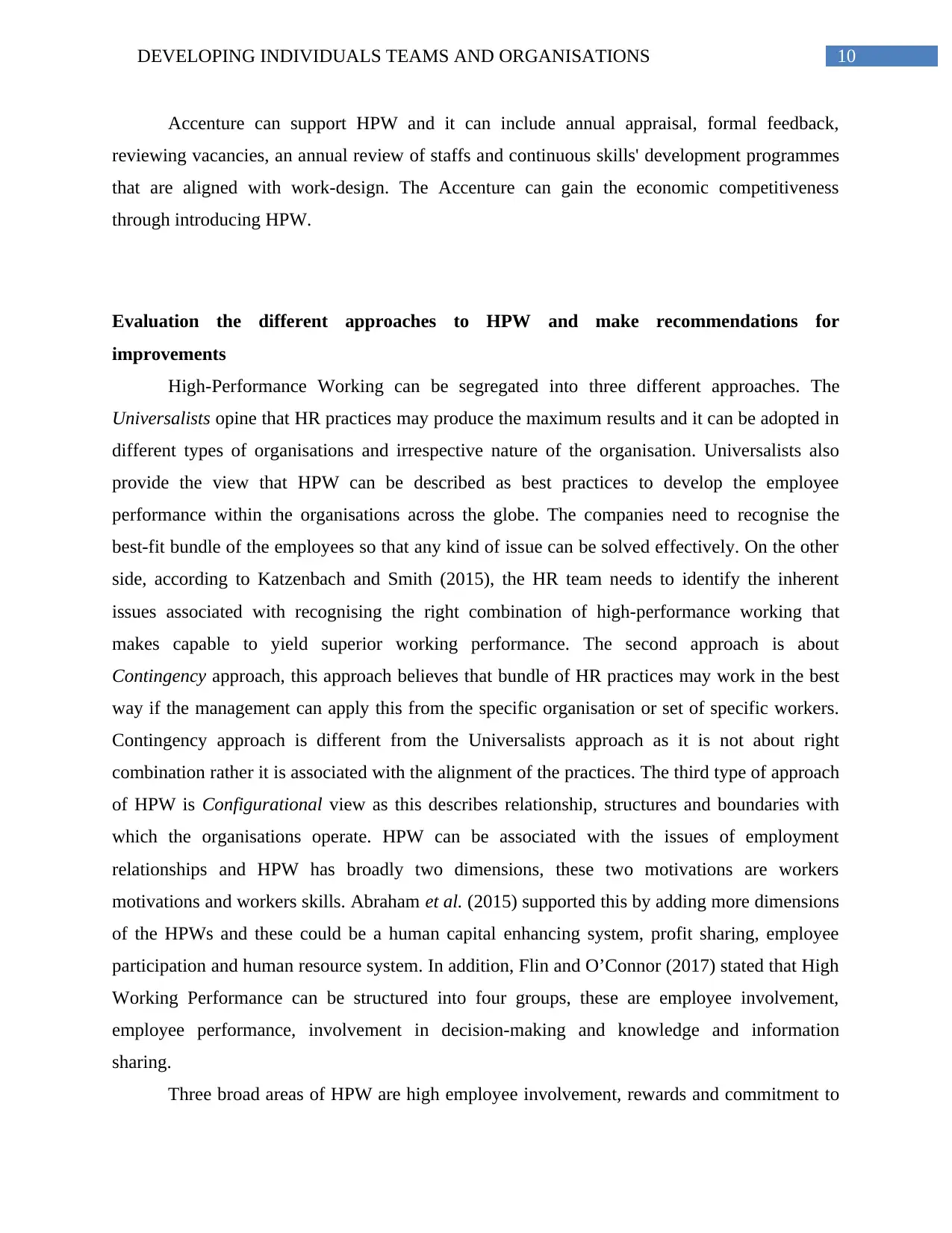
10DEVELOPING INDIVIDUALS TEAMS AND ORGANISATIONS
Accenture can support HPW and it can include annual appraisal, formal feedback,
reviewing vacancies, an annual review of staffs and continuous skills' development programmes
that are aligned with work-design. The Accenture can gain the economic competitiveness
through introducing HPW.
Evaluation the different approaches to HPW and make recommendations for
improvements
High-Performance Working can be segregated into three different approaches. The
Universalists opine that HR practices may produce the maximum results and it can be adopted in
different types of organisations and irrespective nature of the organisation. Universalists also
provide the view that HPW can be described as best practices to develop the employee
performance within the organisations across the globe. The companies need to recognise the
best-fit bundle of the employees so that any kind of issue can be solved effectively. On the other
side, according to Katzenbach and Smith (2015), the HR team needs to identify the inherent
issues associated with recognising the right combination of high-performance working that
makes capable to yield superior working performance. The second approach is about
Contingency approach, this approach believes that bundle of HR practices may work in the best
way if the management can apply this from the specific organisation or set of specific workers.
Contingency approach is different from the Universalists approach as it is not about right
combination rather it is associated with the alignment of the practices. The third type of approach
of HPW is Configurational view as this describes relationship, structures and boundaries with
which the organisations operate. HPW can be associated with the issues of employment
relationships and HPW has broadly two dimensions, these two motivations are workers
motivations and workers skills. Abraham et al. (2015) supported this by adding more dimensions
of the HPWs and these could be a human capital enhancing system, profit sharing, employee
participation and human resource system. In addition, Flin and O’Connor (2017) stated that High
Working Performance can be structured into four groups, these are employee involvement,
employee performance, involvement in decision-making and knowledge and information
sharing.
Three broad areas of HPW are high employee involvement, rewards and commitment to
Accenture can support HPW and it can include annual appraisal, formal feedback,
reviewing vacancies, an annual review of staffs and continuous skills' development programmes
that are aligned with work-design. The Accenture can gain the economic competitiveness
through introducing HPW.
Evaluation the different approaches to HPW and make recommendations for
improvements
High-Performance Working can be segregated into three different approaches. The
Universalists opine that HR practices may produce the maximum results and it can be adopted in
different types of organisations and irrespective nature of the organisation. Universalists also
provide the view that HPW can be described as best practices to develop the employee
performance within the organisations across the globe. The companies need to recognise the
best-fit bundle of the employees so that any kind of issue can be solved effectively. On the other
side, according to Katzenbach and Smith (2015), the HR team needs to identify the inherent
issues associated with recognising the right combination of high-performance working that
makes capable to yield superior working performance. The second approach is about
Contingency approach, this approach believes that bundle of HR practices may work in the best
way if the management can apply this from the specific organisation or set of specific workers.
Contingency approach is different from the Universalists approach as it is not about right
combination rather it is associated with the alignment of the practices. The third type of approach
of HPW is Configurational view as this describes relationship, structures and boundaries with
which the organisations operate. HPW can be associated with the issues of employment
relationships and HPW has broadly two dimensions, these two motivations are workers
motivations and workers skills. Abraham et al. (2015) supported this by adding more dimensions
of the HPWs and these could be a human capital enhancing system, profit sharing, employee
participation and human resource system. In addition, Flin and O’Connor (2017) stated that High
Working Performance can be structured into four groups, these are employee involvement,
employee performance, involvement in decision-making and knowledge and information
sharing.
Three broad areas of HPW are high employee involvement, rewards and commitment to
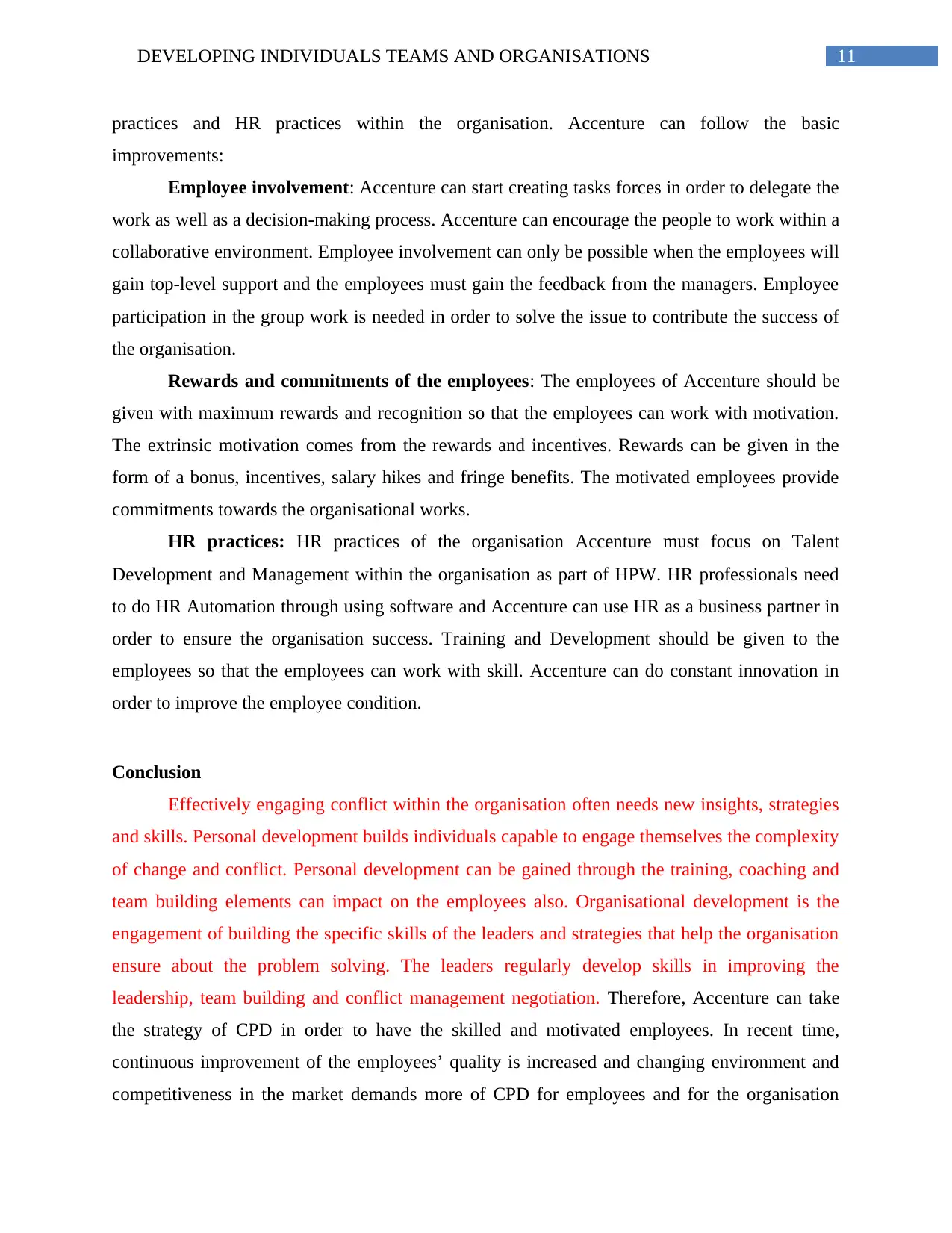
11DEVELOPING INDIVIDUALS TEAMS AND ORGANISATIONS
practices and HR practices within the organisation. Accenture can follow the basic
improvements:
Employee involvement: Accenture can start creating tasks forces in order to delegate the
work as well as a decision-making process. Accenture can encourage the people to work within a
collaborative environment. Employee involvement can only be possible when the employees will
gain top-level support and the employees must gain the feedback from the managers. Employee
participation in the group work is needed in order to solve the issue to contribute the success of
the organisation.
Rewards and commitments of the employees: The employees of Accenture should be
given with maximum rewards and recognition so that the employees can work with motivation.
The extrinsic motivation comes from the rewards and incentives. Rewards can be given in the
form of a bonus, incentives, salary hikes and fringe benefits. The motivated employees provide
commitments towards the organisational works.
HR practices: HR practices of the organisation Accenture must focus on Talent
Development and Management within the organisation as part of HPW. HR professionals need
to do HR Automation through using software and Accenture can use HR as a business partner in
order to ensure the organisation success. Training and Development should be given to the
employees so that the employees can work with skill. Accenture can do constant innovation in
order to improve the employee condition.
Conclusion
Effectively engaging conflict within the organisation often needs new insights, strategies
and skills. Personal development builds individuals capable to engage themselves the complexity
of change and conflict. Personal development can be gained through the training, coaching and
team building elements can impact on the employees also. Organisational development is the
engagement of building the specific skills of the leaders and strategies that help the organisation
ensure about the problem solving. The leaders regularly develop skills in improving the
leadership, team building and conflict management negotiation. Therefore, Accenture can take
the strategy of CPD in order to have the skilled and motivated employees. In recent time,
continuous improvement of the employees’ quality is increased and changing environment and
competitiveness in the market demands more of CPD for employees and for the organisation
practices and HR practices within the organisation. Accenture can follow the basic
improvements:
Employee involvement: Accenture can start creating tasks forces in order to delegate the
work as well as a decision-making process. Accenture can encourage the people to work within a
collaborative environment. Employee involvement can only be possible when the employees will
gain top-level support and the employees must gain the feedback from the managers. Employee
participation in the group work is needed in order to solve the issue to contribute the success of
the organisation.
Rewards and commitments of the employees: The employees of Accenture should be
given with maximum rewards and recognition so that the employees can work with motivation.
The extrinsic motivation comes from the rewards and incentives. Rewards can be given in the
form of a bonus, incentives, salary hikes and fringe benefits. The motivated employees provide
commitments towards the organisational works.
HR practices: HR practices of the organisation Accenture must focus on Talent
Development and Management within the organisation as part of HPW. HR professionals need
to do HR Automation through using software and Accenture can use HR as a business partner in
order to ensure the organisation success. Training and Development should be given to the
employees so that the employees can work with skill. Accenture can do constant innovation in
order to improve the employee condition.
Conclusion
Effectively engaging conflict within the organisation often needs new insights, strategies
and skills. Personal development builds individuals capable to engage themselves the complexity
of change and conflict. Personal development can be gained through the training, coaching and
team building elements can impact on the employees also. Organisational development is the
engagement of building the specific skills of the leaders and strategies that help the organisation
ensure about the problem solving. The leaders regularly develop skills in improving the
leadership, team building and conflict management negotiation. Therefore, Accenture can take
the strategy of CPD in order to have the skilled and motivated employees. In recent time,
continuous improvement of the employees’ quality is increased and changing environment and
competitiveness in the market demands more of CPD for employees and for the organisation
⊘ This is a preview!⊘
Do you want full access?
Subscribe today to unlock all pages.

Trusted by 1+ million students worldwide
1 out of 15
Related Documents
Your All-in-One AI-Powered Toolkit for Academic Success.
+13062052269
info@desklib.com
Available 24*7 on WhatsApp / Email
![[object Object]](/_next/static/media/star-bottom.7253800d.svg)
Unlock your academic potential
Copyright © 2020–2025 A2Z Services. All Rights Reserved. Developed and managed by ZUCOL.



